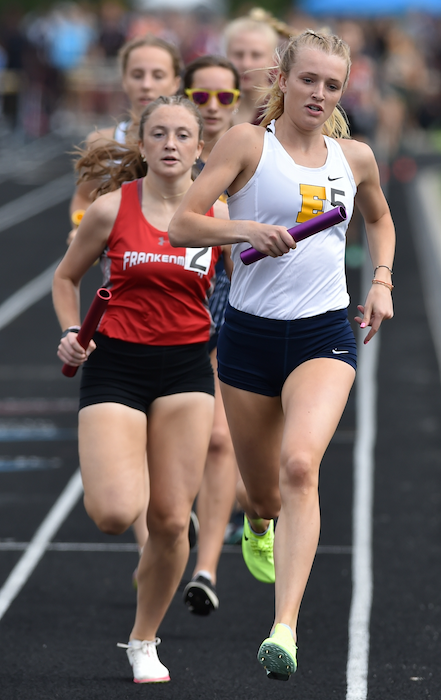
Add, Subtract, Divide, Multiply: MHSAA Not Alone
July 25, 2017
By Rob Kaminski
MHSAA benchmarks editor
This is the third part in a series on MHSAA tournament classification, past and present, that will be published over the next two weeks. This series originally ran in this spring's edition of MHSAA benchmarks.
As the MHSAA faces its most recent classification task with 8-Player Football, and opinions continue to swirl about as to the method, timeframe, location and other procedures, a look around the country provides plenty of company among state association brethren factoring variables into their own equations.
In the Pacific Northwest, the Oregon School Activities Association Football Playoffs are under public scrutiny as leadership ponders a five or six classification format beginning with the 2018-19 school year.
The OSAA has crowned six champions on the gridiron since 2006-07. Many of the state’s smaller schools would like to keep it that way, while larger schools lean toward a five-classification system, citing larger leagues, ease of travel and credibility to state championships as the advantages.
Still others would prefer more than six classes, pointing to safety issues and the opportunity to increase participation numbers as positives.
Moving southeast of Oregon, the Nevada Interscholastic Activities Association recently voted to hold serve on a classification proposal that was volleyed to the membership.
However, changes still could be forthcoming by as early as the 2018-19 season which would add a fifth classification in more populated southern Nevada while allowing northern schools to participate in four classifications. Such divisions could mean no state championship for the fifth class in southern Nevada.
Because of that, the NIAA wants equal numbers of schools in each classification on both ends of the state. Complicating the issue is the fact that the 24 largest schools in the state, by enrollment, are all in Clark County in Southern Nevada.
Across Nevada’s border into Arizona, charter schools are asking the Arizona Interscholastic Association to reconsider classification that was voted upon and approved in September 2015. That agreement called for the largest 33 percent of charter schools by enrollment to be placed in the state’s largest school classification, 3A, the middle 33 percent into 2A, and the smallest 33 percent into 1A.
Less than two years later the charter schools have had a change of heart and have asked to be considered the same as other Arizona public schools and be placed appropriately by enrollment beginning with the 2018-19 school year.
The situation in Arizona further illustrates how the public/private debate that all state associations have faced throughout existence now has the added dynamic of rapidly growing charter schools in today’s educational system, along with virtual school enrollment.
In the nation’s heartland, Nebraska has retooled its football classifications by using enrollment of boys students only in its schools rather than total enrollment. The Nebraska School Activities Association football-playing schools will kick off the 2018 season using this alignment.
Nebraska has three classes of 11-player football, with the smallest class divided in two, Class C-1 and C-2. The state also will have 8-player football for boys enrollments under 47, and the NSAA will sponsor a new 6-player tournament in 2018 for schools with 27 or fewer boys.
“This is a good proposal because some schools have a sizable imbalance between the number of boys and girls, and there’s a large gap (in enrollment) between the largest and smallest schools in Classes A and B,” NSAA executive director Jim Tenopir said. “I think this addresses both of those concerns.”
Swimmers in Georgia, meanwhile, will feel like they are moving with the current, rather than upstream in 2017-18, as the Georgia High School Association recently doubled the number of team championship events from two to four.
Swim enthusiasts can also count on longer days at the finals, as the top 30 finishers from the prelims will advance to the finals instead of 20, and all championship events will have three heats versus two.

Divine Child Piles Up Points Across Several Events to Earn Podium Climb
By
Scott DeCamp
Special for MHSAA.com
June 2, 2024
HAMILTON – After Dearborn Divine Child’s girls track & field team had captured its first MHSAA Finals title in 11 years Saturday at Hamilton’s Hawkeye Stadium, head coach Danny Foster rattled off the names of the coaches on his staff.
Makes sense: The Falcons earned their latest championship largely through a group effort.
Led by freshman Aubrey Wilson and a cast of point-winners, Divine Child seized the Lower Peninsula Division 2 championship by totaling 46 points. Yale was runner-up with 39 points, followed by East Grand Rapids in third (36), Romulus Summit Academy North fourth (33), and Saginaw Swan Valley fifth (25).
“It’s the best feeling in the world, especially when you know what your young people have went through to get to this point – the belief, the hard work,” said Foster, who is in his first season at the Divine Child helm but has coached for more than three decades, much of that time spent in the Detroit Public School League.
“I mean, to understand and know what they go through, it’s awesome. They are a talented group, dedicated to what we do, to what we believe. The girls team, the boys team, we’re all one team and that’s how they’ve worked all year. They come to work.”
Wilson certainly made a mark in her debut season. She took first place in the 100-meter dash with a time of 12.33 seconds and runner-up in the 200 (25.15). Wilson also ran a leg on Divine Child’s second-place 800 relay team and fifth-place 400 relay quartet.
Junior Kathryn Kurtinaitis also scored valuable points for the Falcons with her runner-up finish in the 400 (57.92).
Divine Child’s depth made a difference. The Falcons placed first and fourth in the 100, second and seventh in the 200, and eighth in the 1,600 relay.
“It’s incredible. I can’t believe we made it. It’s unbelievable. I’ve been dreaming about this night (for a long time). I’m really happy right now,” Wilson said. “(Winning the 100) was so unexpected. I mean, my start (was not ideal). It was a little wobbly, but I’m proud that I kept going through and I trusted the process.
“The way I got here is that I practiced and I worked at it. I wouldn’t be here today without my motivation from my teammates especially, going to practice every day, cheering me on. It was an incredible season. I’m really happy how it ended.”
 Saginaw Swan Valley junior Sydney Kuhn also was very pleased with her day.
Saginaw Swan Valley junior Sydney Kuhn also was very pleased with her day.
Kuhn raced to first-place finishes in the 200-meter and 400 dashes. She ran 24.89 in the 200 and a personal record of 55.06 in the 400, plus she anchored the Vikings’ 1,600 relay team that placed fourth.
“It’s been a great season and just a lot of fun,” said Kuhn, who did not play basketball this year because her focus was on track. “Last year I struggled with a (stress fracture) injury, but this year it’s just been amazing. I’ve PR’d, like, every race I’ve ran so it’s just been a lot of fun.”
For East Grand Rapids senior Drew Muller, who won her third straight Finals title in the 1600-meter run, “fun” was the operative word of her final track season with the Pioneers.
Muller won the 1,600 on Saturday with a season-best time of 4:51.49. She also anchored East Grand Rapids’ first-place 1,600 and 3,200 relay teams and placed sixth in the 800.
Muller was part of MHSAA Division 2 title teams for East Grand Rapids in 2022 and 2023. She was also an individual Finals champ in cross country and part of a team that captured a state title in that sport.
“Individually, I had an OK season, so it felt good to kind of end if off in high school at East in a really good spot,” said Muller, who has signed with University of Virginia.
“I wanted to end on, like, a good attitude and savor all the fun high school moments. Super excited to race next year in college, but I’m going to miss this team so much. I have probably stuck with running because of this team. I’ve been trying to savor every senior moment.”
Chelsea senior Leila Wells also made the most of her final high school track meet. She collected her second 100-meter hurdles title in three years with a PR time of 14.92 despite being seeded fifth in the event. She did not compete at the Finals last year because of an ankle injury.
Wells is taking her athletic talents to Virginia Tech, where the 5-foot-7 shooting guard will play basketball.
“It’s been a whole year, so I was kind of hungry and had that fire to be back all season,” Wells said. “Actually being here was amazing. I came in seeded fifth from the Regional, so I was really passionate about running my best time today.”
Other event champions Saturday included: Goodrich’s Layla Jordan in the 800 (2:09.92), St. Johns’ Ava Schafer in the 3,200 (10:39.77), Yale’s Sadie Dykstra in the 300 hurdles (45.00) and long jump (18-½), Eastpointe’s Kalia Monroe in shot put (45-6), Marysville’s Janae Hudson in discus (140-3), Hastings’ Bella Friddle in high jump (5-5), and Ortonville Brandon’s Allison Shelton in pole vault (11-9).
Summit Academy North won the 400 relay (48.75) and the 800 relay (1:40.95). Coldwater junior Brianna Barle won the 100 and 200 adaptive race championships.
Foster gave a shout-out to his four “awesome” seniors and stressed that Divine Child’s team title came through a team effort.
“They put in so much work. Whatever we asked of them, they put in the extra mile. They look at us sometimes, but they put that smile on and they say, ‘OK, coach.’ And that’s what made them so special and they worked so hard,” he said.
“I mean, these young ladies have worked hard since day one. They’re just a special group.”
PHOTOS (Top) Members of Dearborn Divine Child’s girls track & field team hold up their latest championship trophy Saturday. (Middle) East Grand Rapids’ Drew Muller leads the pack during a relay win. (Click for more from Dave McCauley/RunMichigan.com.)

